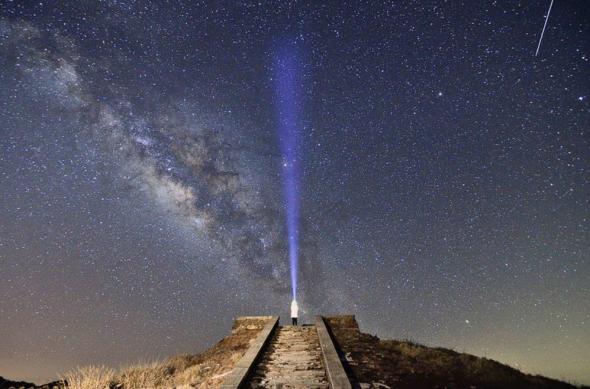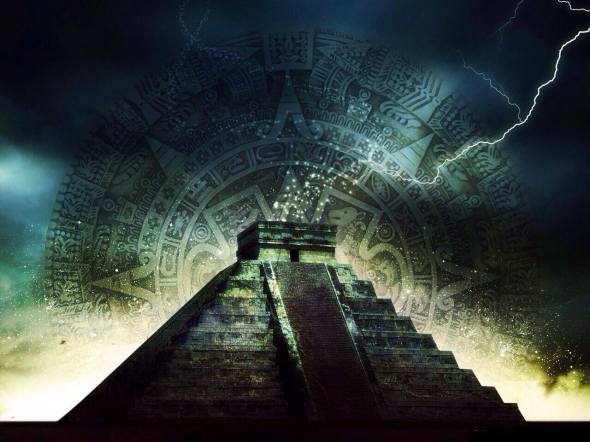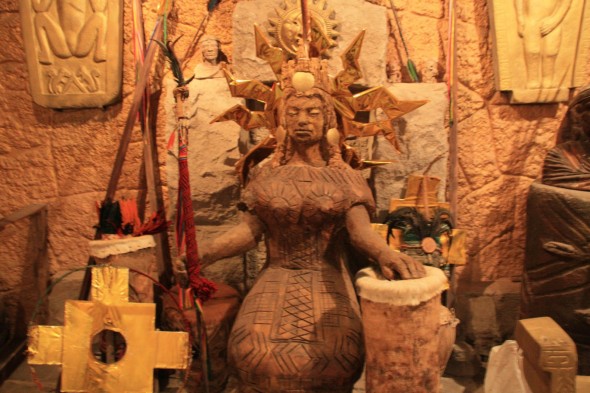The Mesoamericans and the Stars

To the Mesoamerican people (the people who lived in what is today Mexico) the study of time and space was of extreme importance to their culture. The Mayans and Aztecs built their cities and temples along astronomical alignments. To these people, the events of time and space were connected — just as physicists know today that time and space are connected. And they had extremely accurate calendars and astronomical observations that they made with the naked eye. The calculations of Maya priests were so precise that their calendar correction is 10,000th of a day more exact than the standard calendar the world uses today! (Source)
This article will include information about both the Mayans and the Aztecs, because the two civilizations had similar cultures. Obviously not exactly the same, but just as the Greeks influenced the Romans, so too did the Mayans influence the Aztecs. If you are to study one, it is important to study the other.

DISCLAIMER: This is according to what we know currently. Much knowledge about the Aztecs and the Mayans was lost over time, and a lot of it was destroyed or skewed by the Spaniards who came and conquered the Aztecs. Many written codices of Aztec knowledge were destroyed for containing “pagan information.” (Which is a shame because it is believed these codices included information on astronomy, medicine, culture and ritual). And some of the practices of the Aztec people were exaggerated by the Spanish.
THE MESOAMERICAN CALENDARS

The Mayan Calendar (and later Aztec Calendar) is probably one of the more accurate and complex calendars to exist throughout the history of civilization. The Mayan Calendar involves two inter-locking calendars.
The first calendar is called Haab. It is 365 days and approximates the solar year. The word “Haab” means year in the Yucatec Mayan language. But it wasn’t entirely like our calendar today. Instead of having 12 different 30 day months, they had 18 months made up of 20 days each. These 18 months together equal 360 days. And then they add a last month called Wayeb that is made up of 5 days. Some believe these were considered dark days of bad luck. Others believe that this was supposed to be a time of transition and reflection as the new year approached.
The Haab solar calendar was important for marking and observing weather and the seasons, so farmers could figure out when to grow their crops.
The second calendar is called Tzolk’in. The calendar combines 20 named days with 13 numbers, which results in 260 days. The length of Tzolk’in, the 260 days, matches the nine cycles of the moon and the gestational period of humans. The Tzolk’in is also related to the movements of the sun and the growing cycle for corn.
The interlocking calendars: As I said above, the two calendars are interlocked like gears. In the calendar round, a given combination of Tzolk’in and Haab will not repeat itself until 52 periods of 365 days have passed. (Or in other words, 52 years).
The Importance of the 52 Year Cycle: Astronomically, this 52 year cycle was begun when the “Pleiades crossed the fifth cardinal point or the zenith of heaven at midnight.”
The Aztecs used the same interlocking calendar as the Mayans did. And for them, this 52 year cycle was called the “New Fire Ceremony”, which was probably a once in a lifetime event for most Aztec people. On this evening, priests and a warrior chosen by the king began their 20 kilometer procession to the Hill of the Star. At the proper moment of alignment in the heavens, wood bundles representing the past 52 year cycle were lit, the heart sacrifice of the warrior was enacted, and the “new fire” built on his chest. Watching from afar, the citizens also cut and bled themselves and celebrated as the fire was brought back to the Great Temple at Tenochtitlan. Priests and emissaries from outlying towns came to Tenochtitlan to fetch the fire to bring back to their people, so that all could share in the marking of the time as well as symbolically renewing ties with the capital.
THE FIVE SUNS

The five suns are part of the creation myth of the Aztecs and other Nahua peoples. The central tenet of the creation myth was that there were four worlds or “suns” before the current universe, and that currently we’re living in the 5th era.
The present world is the fifth sun, and it is believed that the Aztec saw themselves as “the People of the Sun,” whose divine duty was to wage cosmic war in order to provide the sun with his tlaxcaltiliztli (“nourishment”).
I’m not going to include all the information about the Aztec creation myths here, because there is a lot to go over that is firmly documented elsewhere. But the basic things to know are the following:
Ometeotl: In the beginning, from the void that is the universe, the first god, Ometeotl, created his/her self. Ometeotl was both male and female, good and evil, light and darkness, fire and water, judgment and forgiveness, the god of duality. Ometeotl gave birth to four children, the four Tezcatlipocas, who each preside over one of the four cardinal directions.
Quetzalcoatl: Over the West presides the white Tezcatlipoca, Quetzalcoatl, the god of light, mercy and wind.
Huitzilopochtli: Over the South presides the Blue Tezcatlipoca, Huitzilopochtli, the god of war.
Xipe Totec: Over the East presides the Red Tezcatlipoca, Xipe Totec, the god of gold, farming and Spring time.
Tezcatlipoca: And over the North presides the Black Tezcatlipoca, also called simply Tezcatlipoca, the god of judgment, night, deceit, sorcery and the Earth.
What is interesting to me is that they believed the sun has five phases, and scientists today believe that the life-cycle of a star has five phases (life-cycle of a star).
Also, scientists today believe the Earth has gone through five major cycles of extinction, and we are currently approaching a sixth one caused by human beings. While this doesn’t entirely line up with the Aztec mythos (which believes we are in the 5th cycle), it is interesting to me that they were close.
WATCH VIDEO ON CREATION MYTH HERE

LINKS
How the Sun, Moon and Planets Appear in Ancient Mayan Astronomy (Thoughts.co)
Maya Civilization: The Mayan Calendar (Web.Archive.Org)
Mayan Civilization (Wikipedia)
The Maya Calendar System (Living Maya Time)
The Maya Were Tracking the Planets Long Before Copernicus (Live Science)
Aztec Astronomy and Observation of Nature (Dellerae)
Aztec Astronomy (Inca Mayan Aztec.com)
Pictures of the Aztec Gods (Pinterest)
The Five Suns (Wikipedia)
Black Sun Mythology (Wikipedia)
Bolivia’s “Law of Mother Earth”

In America (and throughout other parts of the world) there is a strong discussion of “human rights.” Humans have a right to this, and humans have a right to that. But we’re only one small species in the vast web of creation. What about the laws of the planet? The laws of Mother Earth?
In Bolivia, they have such a thing. “Ley de Derechos de La Madre Tierra” (The Rights of Mother Earth). This law holds that the land is sacred. It is a living system that has the right to be protected from exploitation, and creates a set of distinguished rights for the environment.
The Law of Mother Earth includes the following rights for the planet:
1. To life: The right to maintain the integrity of living systems and natural processes that sustain them, and capacities and conditions for regeneration.
2. To the diversity of life: It is the right to preservation of differentiation and variety of beings that make up Mother Earth, without being genetically altered or structurally modified in an artificial way, so that their existence, functioning or future potential would be threatened.
3. To water: The right to preserve the functionality of the water cycle, its existence in the quantity and quality needed to sustain living systems, and its protection from pollution for the reproduction of the life of Mother Earth and all its components.
4. To clean air: The right to preserve the quality and composition of air for sustaining living systems and its protection from pollution, for the reproduction of the life of Mother Earth and all its components.
5. To equilibrium: The right to maintenance or restoration of the interrelationship, interdependence, complementarity and functionality of the components of Mother Earth in a balanced way for the continuation of their cycles and reproduction of their vital processes.
6. To restoration: The right to timely and effective restoration of living systems affected by human activities directly or indirectly.
7. To pollution-free living: The right to the preservation of any of Mother Earth’s components from contamination, as well as toxic and radioactive waste generated by human activities.
The document also has a set of obligations that are the duties of the people to the environment. You can see more of that in the information below.
FOR MORE INFORMATION, CHECK OUT THE FOLLOWING LINKS
Law of Mother Earth Complete Text (World Future Fund)
Law of the Rights of Mother Earth (Wikipedia)
Bolivia passes “Law of Mother Earth” which gives rights to our planet as a living system (The Earth Child)
Aztec War Poetry

The following “Song-Poems” are taken from the Cantares Mexicanos, a late 16th-century collection transcribed by a Franciscan monk, Bernardino de Sahagún – of Náhuatl-language (Aztec) poetry known as “flower and song” (” xóchitl in cuícatl “): stylized, symbolic poem forms composed and performed by nobles – including kings. These song-poems were believed to be carriers of sacred ritual energy. (Original Source: “War is Like a Flower“)

To the God of War: Huitzilopochtli
Huitzilopochtli, the Warrior,
He who acts on high
Follows his own path.
Oh marvellous dweller among clouds,
Oh dweller in the region of the frozen wings.
He causes the walls of fire to fall down
Where the feathers are gathered.
Thus he wages war
And subdues the Peoples.
Eager for war, the Flaming One descends,
He rages where the whirling dust arises.
Come to our aid !
There is War, there is burning.
Those Pipitlan are our enemies…
Explanation of Terms:
Huitzilopochtli: Aztec god of War, from the Náhuatl words for
“hummingbird of the left-side/south-side” – the hummingbird being
known for its aggression, daring, and persistence
Pipitlan: a people to the south of Tenochtitlan (capital of the
Aztec Empire, site of present-day Mexico City)
Heart, have no fright.
There on the battlefield
I cannot wait to die
by the blade of sharp obsidian.
Our hearts want nothing but a war death.
You who are in the struggle:
I am anxious for a death
from sharp obsidian.
Our hearts want nothing but a war death.

Sacred crazy flowers,
flowers of bonfires,
our only ornament,
war flowers.
How do they fall? How do they fall?
These hearts, ripe fruit for harvest**.
Look at them,
These fall, the hearts — oh our arrows
These fall, the hearts — oh our arrows.
Explanation of Terms: **These hearts, ripe fruit for harvest – a reference to the
human hearts that must be offered to Tonatiuh – the Sun god –
to ensure he will make his daily journey across the sky;
Tlaloc, the Rain god, also required human hearts – and
Waging War was the surest method to get them…)

Where are you going? Where are you going?
To war, to the sacred water.
There our mother, Flying Obsidian,
dyes men, on the battlefield.
The dust rises
on the pool of flame,
the heart of the god of sun is wounded.
Oh Mactlacueye, oh Macuil Malinalli!
War is like a flower.
You are going to hold it in your hands.
Explanation of Terms: Mactlacueye – volcano north of the present-day city of Puebla;
locally known as La Malinche
Macuil Malinalli – a friend of Aztec King Nezahualpilli (1465-1515)
Brazilian Believers of Hidden Religion Step Out of Shadows
Brazil has one of the largest Black African Populations in the world.
Yet by the power structures and religious oppression that has existed for years, you wouldn’t know it.
But a recent religious poll has shown a sharp uptick in the number of people who call themselves “Candomblé.”
Candomblé is an Afro-Brazilian religion similar to Yoruba.
There is an incorporation of Catholic saints and a belief in one powerful deity who is served by lesser deities.
People are beginning to bring the practice out of basements and into the streets.
However, a large part of the Brazilian population is also becoming Evangelical. Hopefully the Candomblé can continue their religious practices without too much pressure from the Evangelical Christians.
Tomb Reveals Peruvian Queens Who Ruled Over A Brutal Culture
Was the Ancient World all flower power?
Maybe the sacrificial victims were crowned with flower garlands before they met a bloody end.
People assume that Matriarchal authority is a peaceful affair.
Yet the Ancient Queens of Peru beg to differ.
















